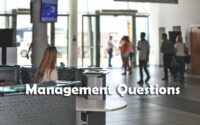Retail Management Interview Questions
Retail Management Interview Questions is given below. Candidates who are looking for Retail Management Interview Questions can find in this section. Aspirants can download the latest Retail Management Interview Questions. Here we are providing Retail Management Interview Questions in a PDF format.

Download Retail Management Interview Questions at free of cost. We have displaced Retail Management Interview Questions along with solutions. People can use the Retail Management Interview Questions as a reference in your preparation.
Questions on Retail Management
1. Shadow prices of economic resources are given by:
(A) Optimal solution of Dual
(B) Optimal solution of Primal
(C) Intermediate solution of Dual
(D) Intermediate solution of Primal
2. Degeneracy in Linear Programming Simplex Solution is indicated by:
(A) Tie in the smallest positive ratio
(B) Tie in the largest Cj-Zj value
(C) No. of occupied cells is less than m + n – 1
(D) No. of occupied cells is more than m + n – 1
3. Markov Analysis is not applicable to:
(A) Brand Switching
(B) Brand Positioning
(C) Maintenance Management
(D) Accounts Receivables
4. In a decision tree model, when the result of taking a decision is uncertain, then the result is represented by:
(A) A line
(B) A triangle
(C) A square
(D) A circle
5. In order to find independence of two variables which are attributes, the following test is most appropriate test:
(A) ‘t’ test
(B) ‘Z’ test
(C) ‘F’ test
(D) ‘Chi-square’ test
6. In cluster sampling, the clusters are so formed as:
(A) The units in the cluster are as homogeneous as possible
(B) The units in the cluster are as heterogeneous as possible
(C) The clusters are heterogeneous among themselves
(D) Some stratification factor may be chosen
7. If the value of r(Karl Pearson’s Correlation Coefficient) is = –0.1 then:
(A) Only byx must be –ve
(B) Only bxy must be –ve
(C) Both byx and bxy must be –ve
(D) Both byx and bxy must be +ve
8. If P(A) = 0.6, P(B) = 0.3, P(A ∩ B) = 0.2, then P(A/B) is:
(A) 0.1
(B) 0.333
(C) 0.50
(D) 0.6607
9. Which of the following is not an alternative hypothesis?
(A) H1: m ≠ m0
(B) H1: m > m0
(C) H1: m < m0
(D) H1: m = m0
10. The mechanism whereby the organization seeks to earn a profit by selling its goods is known as:
(A) Competitive advantage
(B) Distinctive advantage
(C) Business model
(D) Competitive competence
11. Diversification mainly allows a firm to:
(A) Concentrate on a single business
(B) Create excess resources
(C) Use its resources more effectively
(D) Send its directors on foreign tours
12. Divestment strategy is pursued when:
(A) The industry is flourishing
(B) Many takeovers have already taken place
(C) The industry is in decline stage
(D) R&D is not adequate
13. Differentiated business firms are vulnerable to:
(A) Diversification by rivals
(B) Regulatory changes
(C) High costs of R&D
(D) Low-cost competitors offering similar products
14. Global Entry Strategies are not based on:
(A) Capacity of the shipping-line normally used by a company
(B) Import Policy of the foreign country
(C) Costs of manufacturing products abroad
(D) Requirement of company’s products in foreign markets
15. The person who introduced the term ‘entrepreneur’ was:
(A) Peter Drucker
(B) J.S. Mill
(C) Richard Cantillon
(D) Schumpeter
16. Which is the key factor that an entrepreneur should focus on, in ensuring survival of his enterprises?
(A) Profits
(B) Cash flow
(C) Margin
(D) Market Share
17. The idea that, ‘Extra-ordinary individuals’ are the source of entrepreneurial emergence, is putforth by:
(A) McClelland
(B) Schumpeter
(C) Weber
(D) Drucker
18. In case of SSIs, who said that ‘small is beautiful’?
(A) E.F. Schumacher
(B) Peter Drucker
(C) Mahatma Gandhi
(D) Azim Premji
19. The transformation of an idea into useful application is termed as:
(A) Creativity
(B) Invention
(C) Innovation
(D) Syndication
20. Why should business be socially responsible?
(A) To protect customers’ requirement
(B) To increase reputation of the company
(C) To protect and serve public interest
(D) To go for organisational development
21. Which of the practice will not create an ethical culture in an organization?
(A) Visible role models from an organization
(B) Clearly communicating ethical expectations
(C) Provide ethical training
(D) Punishing whistle blowers
22. In which corporate governance model do financial institutions have major say?
(A) American Model
(B) German Model
(C) Japanese Model
(D) Indian Model
23. Dependability, predictability and faith are the three elements that constitute:
(A) Values
(B) Moral principles
(C) Trust
(D) Justice
24. Corporate governance is the key:
(A) To the integrity of corporations
(B) To increase profit
(C) To motivate employees
(D) To implement government policies

